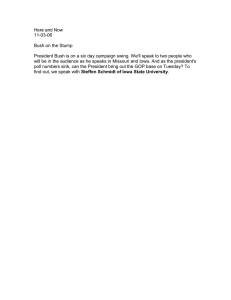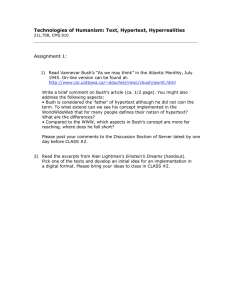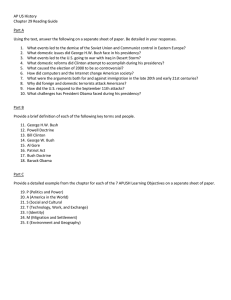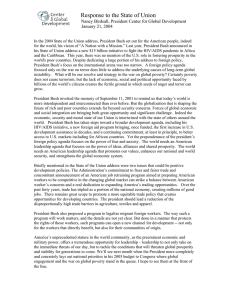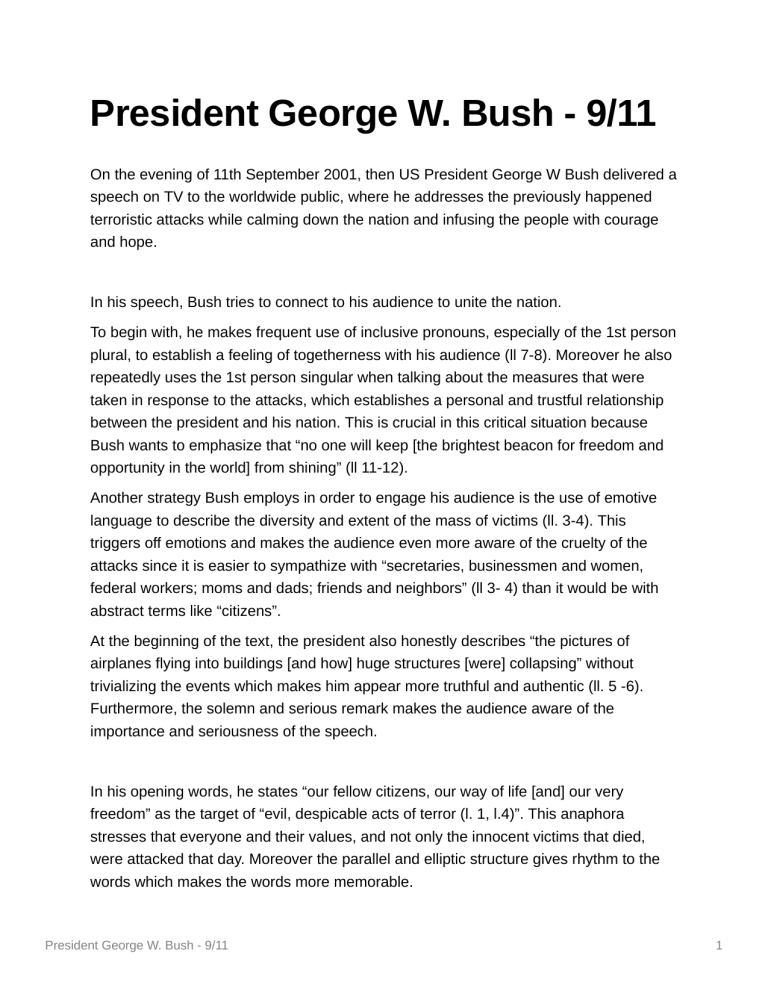
President George W. Bush - 9/11 On the evening of 11th September 2001, then US President George W Bush delivered a speech on TV to the worldwide public, where he addresses the previously happened terroristic attacks while calming down the nation and infusing the people with courage and hope. In his speech, Bush tries to connect to his audience to unite the nation. To begin with, he makes frequent use of inclusive pronouns, especially of the 1st person plural, to establish a feeling of togetherness with his audience (ll 7-8). Moreover he also repeatedly uses the 1st person singular when talking about the measures that were taken in response to the attacks, which establishes a personal and trustful relationship between the president and his nation. This is crucial in this critical situation because Bush wants to emphasize that “no one will keep [the brightest beacon for freedom and opportunity in the world] from shining” (ll 11-12). Another strategy Bush employs in order to engage his audience is the use of emotive language to describe the diversity and extent of the mass of victims (ll. 3-4). This triggers off emotions and makes the audience even more aware of the cruelty of the attacks since it is easier to sympathize with “secretaries, businessmen and women, federal workers; moms and dads; friends and neighbors” (ll 3- 4) than it would be with abstract terms like “citizens”. At the beginning of the text, the president also honestly describes “the pictures of airplanes flying into buildings [and how] huge structures [were] collapsing” without trivializing the events which makes him appear more truthful and authentic (ll. 5 -6). Furthermore, the solemn and serious remark makes the audience aware of the importance and seriousness of the speech. In his opening words, he states “our fellow citizens, our way of life [and] our very freedom” as the target of “evil, despicable acts of terror (l. 1, l.4)”. This anaphora stresses that everyone and their values, and not only the innocent victims that died, were attacked that day. Moreover the parallel and elliptic structure gives rhythm to the words which makes the words more memorable. President George W. Bush - 9/11 1 As already indicated earlier, the author gives a visual and honest description of events that happened without playing anything down. Especially pictorial descriptions like “fires burning” or “huge structures collapsing” help the audience visualize the extent of the consequences of the attacks (ll 5 -6). The usage of negatively connotated terms when describing the terroristic acts as “deliberate and deadly” (l. 2) further emphasizes the authors’ negative attitude towards the events that happened. By doing this, he tries to put the opposing side in the worst light possible. On the other hand, Bush benefits from the use of superlatives as well as positive and valued terms in metaphors, for example when he describes America as “the brightest beacon for freedom and opportunity” (ll. 12-13). This metaphor creates an atmosphere of positivity amongst the people which is extremely crucial in tough times. To a greater extent, Bush also tries to strengthen the nations’ bond by using the metaphor that “these acts shattered steel, but they cannot dent the steel of American resolve.” (ll. 1011) to further emphasize the strength of his country. Another striking metaphor can be found in an antithesis in lines 14 -15, where Bush claims that “[his] nation saw evil [and] responded with the best of America”. This is another way of creating even more contrast between the attackers and America to really put the Land of Liberty above “the very worst of human nature” (l. 14). In the subsequent words, Bush further explains the human strengths of America, by naming the “daring of our rescue workers” or the “caring for strangers and neighbors” as examples in a parallelism & anaphora to, again, focus on the power and robustness as well as the human aspects that make up the United States of America (l.15 ). President George W. Bush - 9/11 2
